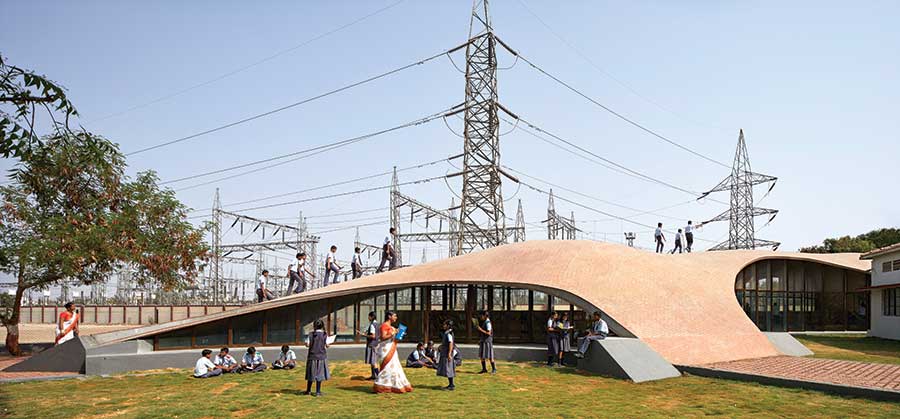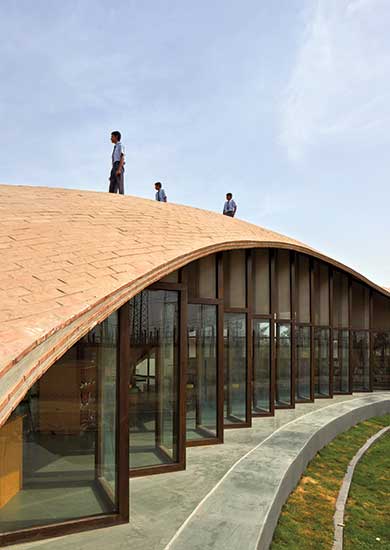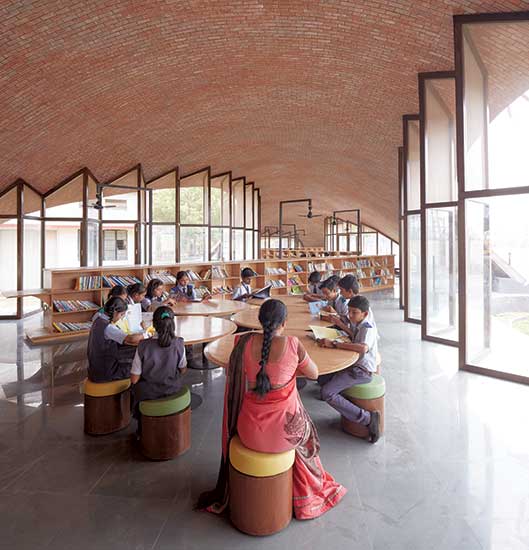Maya Somaiya Library by SP+A
Publish Date
9th January 2019
Area of Interest
Facilities
Type
Online
Source
Institution(s)
Shri Sharda English Medium School, Somaiya Vidyavihar



Nestled into a tight, irregular site on the campus of a public primary and secondary school in the town of Kopargaon in rural India, an undulating form invites students and teachers in—and onto—a new library designed by Mumbai-based architecture practice sP+a.
The Maya Somaiya Library, a 6,000-square-foot masonry structure that replaces a makeshift facility in one of the school’s classroom buildings, provides an enticing new space for study, collaboration, and play. “We wanted people to be attracted to this place,” says Sameep Padora, who founded sP+a in 2006, “so that kids didn’t just look at the library as a container for books, but as something that they can engage with physically.” The firm had previous experience with the client, a philanthropic organization called Somaiya Vidyavihar, that runs schools in the region. “Somaiya Vidyavihar aspires to create an architecture of sensitivity,” says Padora, in tune with the “capacity to inspire young minds.”
Addressing the awkward site, surrounded by nondescript concrete structures, the architects designed the library to feel like part of the landscape, envisioning it as a feature that would enhance, rather than disrupt, the flow of foot traffic between buildings. “We thought of the library as a node for the campus that would allow people to move through and also on top,” says Padora. “And we wanted the students to be able to approach from any side, so we began considering what forms to create with the materials we had.”
Padora and his team looked across history and the globe for inspiration: Catalan tile vaults of the 16th century, as well as Eladio Dieste’s swooping masonry forms in Uruguay and Rafael Guastavino’s “tile arch system” in the United States. The team sourced terra-cotta tiles from a factory in the neighboring state of Gujarat for the compression-only structure. To create the vaulted form, builders defined the curvature of the surface with a grid of rebar, then laid three layers of tile, joining bricks with fast-setting mortar and staggering the joints to form a structure stable enough to enable people to walk on top. Once the mortar set, the contractor removed the rebar and reused it in another project.
Daylight enters the library from all sides through glass walls, folded accordion-style to maximize stability. Using smaller spans of glass was also a more economical choice for the project, which cost roughly $30 per square foot, says the architect. Above each window’s wood frame, a metal grate facilitates passive cooling; the library, like other buildings here, has no air-conditioning, despite the hot, dry climate.
“In rural parts of the country like this, the architectural language is often tied to the material and human resources that are available,” says Padora, who, while working within those constraints, takes things a step further by reinterpreting the vernacular. “We’re more interested in evolution than in the ‘museumication’ of a particular craft,” he says. “We try to see the potential of how it can evolve through the input of different techniques or construction systems.”
Sign up for media coverages
Journalists! please sign up to receive Somaiya Vidyavihar news releases and invitations to events.



